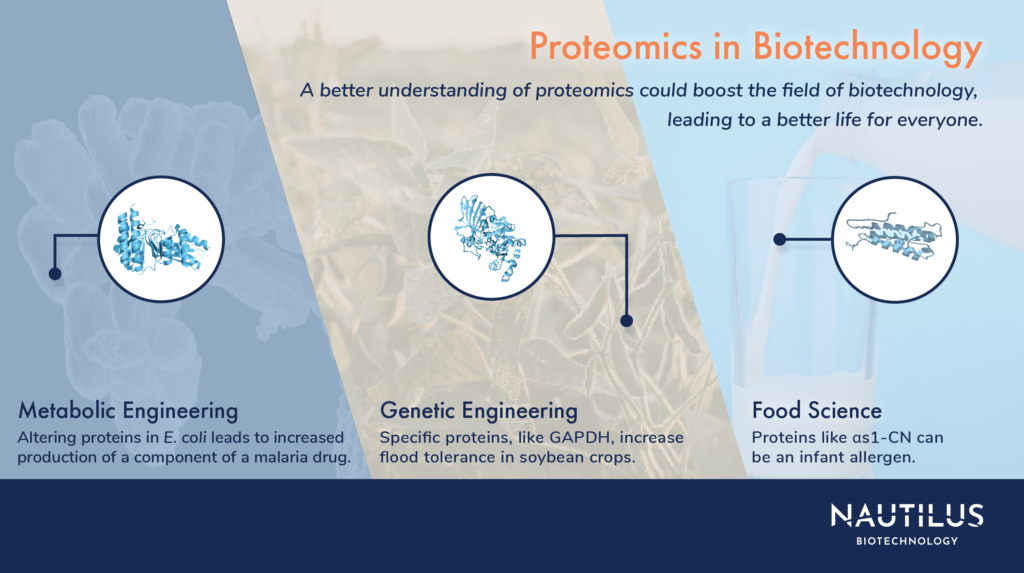
Biotechnology is a broad term that describes human efforts to modify biological systems to better suit our needs. Though biotech has ancient roots, proteomics applications are leading to new possibilities in the field. With proteomics behind them, researchers are discovering new proteins and protein interactions that can be used to design more useful plants, animals, and to improve human life.
Proteomics technologies already give biotechnologists powerful tools for investigating and monitoring biological systems. Next-generation proteomics will be far more comprehensive and accessible and will find many more uses in the world of biotechnology. Proteins are often the central molecules carrying out cellular and organismal functions, whether that’s causing unregulated cell division during cancer or improving milk quality in dairy cattle. That means monitoring and altering proteins can be a critical part of both developing biotechnology and measuring the outcome of biotechnological interventions.
Applications of proteomics in biotechnology: Metabolic engineering
Metabolism is the collection of chemical changes that occur in a cell or organism. It is essential to many cellular processes including properly storing and using energy, producing vitamins, and defending against pathogens. Research shows that metabolism can be affected by protein post-translational processes and metabolic self-regulation, while other studies show that some changes in gene expression can be closely tied to changes in metabolism. All in all, unraveling the confusing, multi-faceted nature of metabolic regulation is a significant challenge – one which proteomics analysis could help address.
In one example, researchers conducted a targeted proteomic analysis of Escherichia coli strains that were engineered to produce a compound necessary for certain malaria drugs. The proteomic information revealed two proteins that created bottlenecks in the metabolic pathway for producing the compound, the researchers write in a paper in the journal Metabolic Engineering. With that information, the researchers were able to alter the genes behind those pathways, greatly improving production of the critical compound.
With metabolic changes being tangled up with changes to genes and proteins, it will take more research using more accurate data to truly understand how changes to genomes and proteomes translate into the molecules produced by cells. New proteins discovered in future proteomics studies may prove to be the missing link in metabolic pathways that are currently not understood, or may unlock the ability to better use bacteria to bioengineer compounds necessary for drugs.
Applications of proteomics in biotechnology: Food science
Everyone wants to know their food is safe and nutritious. Proteomic analysis has become an essential tool for evaluating food quality and safety by enabling scientists to monitor changes that occur in food proteins and to see how these proteins form and break down. Some toxins and contaminants come in the form of proteins, and proteomics tools can directly measure them to identify safe foods. Proteins might also be useful to show whether a food item contains all the ingredients it says on the label, and nothing it doesn’t.
Indeed, proteomics is a powerful tool for detecting the adulteration or contamination of various foods. For example, proteomics can verify the purity of goat and donkey milk for infants, protecting newborns from allergenic cow’s milk contaminants. Proteomics has also been used to differentiate natural from added enzymes in honey, calling out low-quality products and guaranteeing that the honey in the container matches the purity and quality listed on the label. As a final example, proteomics has been applied to food science to detect the addition of soy proteins in meat products, which can compromise their nutrition and safety.
Future advances in next-generation proteomics technologies could further enhance these abilities by expanding the range of protein contaminants it’s possible to detect in samples, and speeding up workflows. New proteomics tools that are simpler and easier to use will also help bring the technology to regions that may not currently have the ability to conduct large-scale proteomics. That would mean everyone would have the ability to ensure the safety and quality of their food supply.
Applications of proteomics in biotechnology: Genetic engineering
Genetic engineering is a process that alters the DNA in a cell or organism to change or improve its function. Genetic engineering has been used for decades in agriculture in the form of genetically-modified organisms, or GMOs, that resist pests, increase yields, tolerate harsh conditions, and more. It can often be difficult to properly target genetic engineering efforts — many genes control more than one thing, for example. Studying proteins to better understand crop and livestock biology can help scientists pinpoint cellular functions to target through genetic engineering. Thus, proteomics can help scientists develop efficient and efficacious genetic engineering strategies.
For example, in one study in the International Journal of Molecular Sciences, scientists used a proteomic analysis to compare flood-resistant soybean varieties with susceptible varieties. They identified dozens of proteins associated with flood tolerance and grouped them by core metabolic pathways. Then, they used computational modeling to predict which proteins and pathways would be the most effective targets of genetic modification, revealing how to engineer more flood-tolerant soybeans.
Applications of proteomics in biotechnology like these are giving researchers a template for future studies of plant and animal engineering, paving a path toward better, more resilient food systems worldwide.
Unlocking future proteomics applications with new tools
Today, proteomics is being used to protect consumers from contaminants, probe the complex biological systems that sustain us, and even help create new varieties of crops to improve agriculture.
To move beyond what’s currently possible, we’ll need to expand our knowledge of the proteome and the millions of proteins and proteofroms it contains. For that, new tools that can quickly and reliably reveal the majority of a samples’ proteome are necessary. The Nautilus Proteome Analysis Platform is designed to unlock the proteome through accessible, high-throughput, comprehensive and sensitive analysis of billions of proteins at the single-molecule level and will hopefully enable applications across biotechnology and beyond.
Listen the Translating Proteomics podcast for a fascinating discussion of the applications of proteomics
MORE ARTICLES


